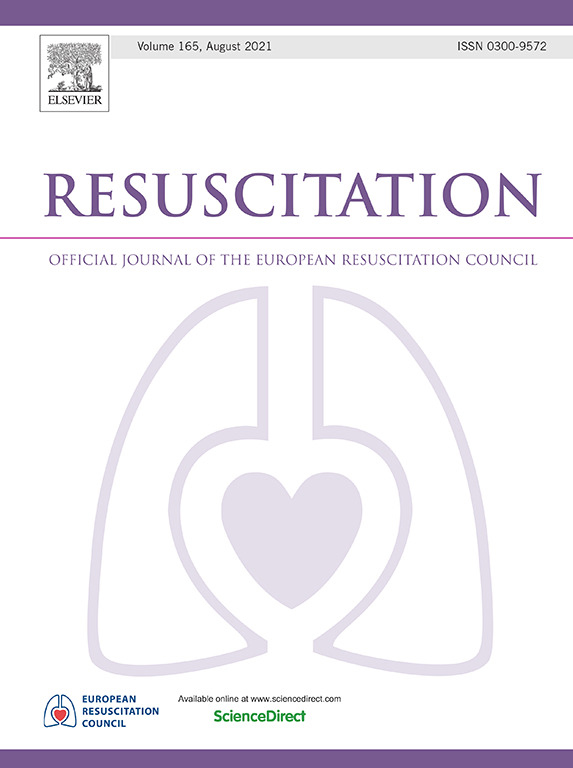Perioperative cardiac arrest and the impact of surgical timing: a nationwide cohort study
IF 4.6
1区 医学
Q1 CRITICAL CARE MEDICINE
引用次数: 0
Abstract
Background
Perioperative cardiac arrest (PO-CA) is a rare but critical event. The impact of surgical timing, i.e. whether procedures are conducted during office hours or out-of-hours, on its occurrence remains unknown. We aimed to outline the incidence and mortality of PO-CA in Sweden, and assess whether surgical timing influences the risk of PO-CA in non-cardiothoracic, non-obstetric emergency surgery.
Methods
We conducted a retrospective cohort study of adult patients (≥18 years) in the Swedish Perioperative Register between 2019 and 2023. We examined the incidence and mortality of PO-CA, defined as cardiac arrest in the operating theatre or post-anaesthesia care unit (PACU). In a subset of non-cardiothoracic, non-obstetric emergency surgery, we estimated the odds of PO-CA in procedures commenced out of hours compared with during office hours, adjusting for sex, age, comorbidities, ASA class, and case urgency, using mixed-effects logistic regression.
Results
Among 1,568,877 procedures, PO-CA occurred in 395 cases (314 in the operating theatre, 81 in the PACU), corresponding to a crude incidence of 2.5/10,000 procedures, with a subsequent 30-day mortality of 42.5 %. In non-cardiothoracic, non-obstetric emergency surgery, the crude odds ratio for PO-CA out of hours vs. office hours was 1.31 (95 % CI 1.00–1.70), while the adjusted odds ratio was 1.13 (95 % CI 0.86–1.48).
Conclusions
In this nationwide study, PO-CA was rare, with over half of affected patients surviving beyond 30 days. Although crude incidence appeared higher out of hours in non-cardiothoracic, non-obstetric emergency surgery, this pattern likely reflects greater patient complexity rather than out-of-hours circumstances per se.
围手术期心脏骤停和手术时机的影响:一项全国性队列研究。
背景:围手术期心脏骤停(PO-CA)是一种罕见但危险的事件。手术时间的影响,即手术是在办公时间还是非工作时间进行,对其发生的影响尚不清楚。我们的目的是概述瑞典PO-CA的发病率和死亡率,并评估手术时机是否影响非心胸、非产科急诊手术中PO-CA的风险。方法:我们对2019年至2023年瑞典围手术期登记的成年患者(≥18岁)进行了回顾性队列研究。我们研究了PO-CA的发病率和死亡率,PO-CA定义为在手术室或麻醉后护理病房(PACU)发生的心脏骤停。在非心胸外科、非产科急诊手术的一个子集中,我们使用混合效应logistic回归,通过调整性别、年龄、合并症、ASA等级和病例紧急程度,估计了在非工作时间开始的手术中发生PO-CA的几率,并与办公时间进行了比较。结果:在1,568,877例手术中,PO-CA发生395例(314例在手术室,81例在PACU),对应的粗发生率为2.5/10,000例手术,随后30天死亡率为42.5%。在非心胸、非产科急诊手术中,PO-CA在工作时间外与办公时间的粗优势比为1.31 (95% CI 1.00-1.70),而调整后的优势比为1.13 (95% CI 0.86-1.48)。结论:在这项全国性的研究中,PO-CA是罕见的,超过一半的患者存活超过30天。尽管非心胸、非产科急诊手术的粗发生率在非工作时间更高,但这种模式可能反映了患者更复杂的情况,而不是非工作时间情况本身。
本文章由计算机程序翻译,如有差异,请以英文原文为准。
求助全文
约1分钟内获得全文
求助全文
来源期刊

Resuscitation
医学-急救医学
CiteScore
12.00
自引率
18.50%
发文量
556
审稿时长
21 days
期刊介绍:
Resuscitation is a monthly international and interdisciplinary medical journal. The papers published deal with the aetiology, pathophysiology and prevention of cardiac arrest, resuscitation training, clinical resuscitation, and experimental resuscitation research, although papers relating to animal studies will be published only if they are of exceptional interest and related directly to clinical cardiopulmonary resuscitation. Papers relating to trauma are published occasionally but the majority of these concern traumatic cardiac arrest.
 求助内容:
求助内容: 应助结果提醒方式:
应助结果提醒方式:


